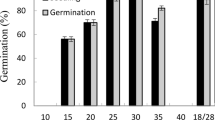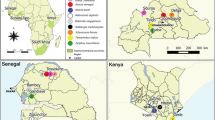Abstract
Threatened plant conservation is fraught with numerous intrinsic and extrinsic challenges, which vary across species. For example, the absence of a standardized regeneration protocol significantly hinders the mass multiplication of seedlings, while insufficient distribution records make it difficult to model their potential distribution area for reintroduction. We standardized the germination protocol in Acer sikkimensis, a threatened tree of northeast India, and modeled the potential distribution area for its reintroduction in Sikkim, northeast India. The seeds collected for the germination experiment were given cold treatment (5 °C) for 3 months to break dormancy. Subsequently, the seeds were soaked in different concentrations of gibberellic acid (GA3), abscisic acid (ABA), indoleacetic acid (IAA), and kinetin to identify the treatment that enhances germination. Control was maintained by soaking the seeds in deionized water. The potential distribution area of the species was modeled using maximum entropy distribution modeling (MaxEnt) software and averaged monthly normalized difference vegetation index (NDVI) data for the study area. The treatment with GA3 and kinetin improved seed germination significantly compared to ABA and IAA. The MaxEnt model performed well with less number of occurrence records. The model predicted that only 38 km2 area in Sikkim was highly suitable for the species where the species can be reintroduced. This study’s seed germination protocol is less expensive than the existing micro-propagation techniques. The proposed germination protocol and the potential distribution area map can be helpful for conservationists, scientists, and local nongovernmental organizations to conserve A. sikkimensis and improve its conservation status.
Access this chapter
Tax calculation will be finalised at checkout
Purchases are for personal use only
Similar content being viewed by others

References
Adhikari D, Barik SK, Upadhaya K (2012) Habitat distribution modelling for reintroduction of Ilex khasiana Purk., a critically endangered tree species of northeastern India. Ecol Eng 40:37–43. https://doi.org/10.1016/j.ecoleng.2011.12.004
Adhikari D, Reshi Z, Datta BK, Samant SS, Chettri A, Upadhaya K, Shah MA, Singh PP, Tiwary R, Majumdar K, Pradhan A (2018) Inventory and characterization of new populations through ecological niche modelling improve threat assessment. Curr Sci 114(03):519–531. https://doi.org/10.18520/cs/v114/i03/519-531
Babar S, Amarnath G, Reddy CS, Jentsch A, Sudhakar S (2012) Species distribution models: ecological explanation and prediction of an endemic and endangered plant species (Pterocarpus santalinus L. f.). Curr Sci 102:1157–1165
Elith J, Leathwick JR (2009) Species distribution models: ecological explanation and prediction across space and time. Annu Rev Ecol Evol Syst 40:677–697. https://doi.org/10.1146/annurev.ecolsys.110308.120159
Elith J et al (2006) Novel methods improve prediction of species’ distributions from occurrence data. Ecography (Cop) 2:129–151. https://doi.org/10.1111/j.2006.0906-7590.04596.x
Guisan A, Thuiller W (2005) Predicting species distribution: offering more than simple habitat models. Ecol Lett 8:993–1009. https://doi.org/10.1111/j.1461-0248.2005.00792.x
Guisan A, Zimmermann NE (2000) Predictive habitat distribution models in ecology. Ecol Model 135:147–186. https://doi.org/10.1016/S0304-3800(00)00354-9
ISTA (1996) International rules for seed testing 1996. The International Seed Testing Association, Zurich
Jaryan V, Datta A, Uniyal SK, Kumar A, Gupta RC (2013) Modelling potential distribution of Sapium sebiferum—an invasive tree species in western Himalaya. Curr Sci 105:1282–1288
Kanazashi A, Nagamitsu T, Suzuki W (2014) Seed dormancy and germination characteristics in relation to the regeneration of Acer pycnanthum, a vulnerable tree species in Japan. J For Res 20:160–166. https://doi.org/10.1007/s10310-014-0451-4
Kumar S, Stohlgren TJ (2009) Maxent modeling for predicting suitable habitat for threatened and endangered tree Canacomyrica monticola in New Caledonia. J Ecol Nat Environ 1:94–98
Lama D, Moktan S, Das AP (2015) Diversity and distribution of Acer Linnaeus (Sapindaceae) in Darjiling and Sikkim Himalayas. Pleione 9:61–73
Nayar MP, Sastry ARK (1990) Red data book of Indian plants, vol 3. Botanical Survey of India, Kolkata
Pearson RG, Raxworthy CJ, Nakamura M, Peterson AT (2007) Predicting species distributions from small numbers of occurrence records: a test case using cryptic geckos in Madagascar. J Biogeogr 34:102–117. https://doi.org/10.1111/j.1365-2699.2006.01594.x
Peterson AT (2006) Uses and requirements of Ecological Niche Models and related distributional models. Biodivers Inform 3:59–72. https://doi.org/10.17161/bi.v3i0.29
Phartyal S, Thapliyal RC, Nayal JS, Joshi G (2003) Seed dormancy in Himalayan maple (Acer caesium) I: effect of stratification and phyto-hormones. Seed Sci Technol 31:1–11. https://doi.org/10.15258/sst.2003.31.1.01
Phillips JS, Dudik M (2008) Modeling of species distributions with Maxent: new extensions and a comprehensive evaluation. Ecography (Cop) 31:161–175. https://doi.org/10.1111/j.0906-7590.2008.5203.x
Phillips SJ, Anderson RP, Schapire RE (2006) Maximum entropy modeling of species geographic distributions. Ecol Eng 190:231–259. https://doi.org/10.1016/j.ecolmodel.2005.03.026
Pinfield NJ, Gwarazimba VEE (1992) Seed dormancy in Acer: the role of abscisic acid in the regulation of seed development in Acer platanoides L. Plant Growth Regul 11:293–299. https://doi.org/10.1007/BF00024568
Pinfield NJ, Stobart AK (1972) Hormonal regulation of germination and early seedling development in Acer pseudoplatanus (L.). Planta 104:134–145. https://doi.org/10.1007/BF00386990
Pradhan A, Adhikari D, Chettri A (2020) Predicting the distribution of suitable habitats for Pandanus Unguifer Hook.F.—a Dwarf endemic species from Sikkim Himalayas, through Ecological Niche Modeling. Int J Conserv Sci 11(1):145–152
Rana MS, Lal M, Samant SS (2011) Status and regeneration of Himalayan maple in the Himachal Pradesh: honing red list of plants. J Sustain For 30(8):775–789
Ray R, Gururaja KV, Ramchandra TV (2011) Predictive distribution modeling for rare Himalayan medicinal plant Berberis aristata DC. J Environ Biol 32(6):725–730
Soleimani K, Kordsavadkooh T, Muosavi SR (2008) The effect of environmental factors on vegetation changes using GIS (case study: Cherat Catchment, Iran). World Appl Sci J 3:95–100
Sreekumar VB, Sakthivel RS, Sreejith KA (2016) Distribution mapping and conservation of Rhopaloblaste augusta (Kurz) H. E. Moore in Nicobar Islands, India. Trop Ecol 57:271–277
Tanai T (1978) Taxonomical investigation of the living species of the genus Acer L., based on vein architecture. J Fac Sci 18:243–282
Thorn JS, Nijman V, Smith D, Nekaris KAI (2009) Ecological niche modelling as a technique for assessing threats and setting conservation priorities for Asian slow lorises (Primates: Nycticebus). Divers Distrib 15:289–298. https://doi.org/10.1111/j.1472-4642.2008.00535.x
Thriveni HN, Gunaga SV, Babu HNR, Vasudeva R (2015) Ecological niche modeling, population status and regeneration of Coscinium fenestratum colebr. (Menispermaceae): a medicinally important liana of the central Western Ghats. Trop Ecol 56:101–110
Thuller W, Richardson DM, Pysek P, Midley GF, Hughes GO, Rouget M (2005) Niche-based modelling as a tool for predicting the risk of alien plant invasions at a global scale. Glob Chang Biol 11:2234–2250. https://doi.org/10.1111/j.1365-2486.2005.01018.x
Tillberg E, Pinfield NJ (1981) The dynamics of Indole-3-acetic-acid in Acer platanoides seeds during stratification and germination. Physiol Plant 53:34–38. https://doi.org/10.1111/j.1399-3054.1981.tb05041.x
Warren D, Richard G, Turelli M (2010) ENMTools: a toolbox for comparative studies of environmental niche models. Ecography 33:607–611. https://doi.org/10.1111/j.1600-0587.2009.06142.x
Wisz MS, Hijmans RJ, Li J, Peterson AT, Graham CH, Guisan A (2008) Effects of sample size on the performance of species distribution models. Divers Distrib 14:763–773. https://doi.org/10.1111/j.1472-4642.2008.00482.x
Yilmaz M (2007) Depth of dormancy and desiccation tolerance in Acer trautvetteri Medv. seeds. Turk J Agric For 31:201–205
Acknowledgments
The financial support received from DBT, Govt. of India, under a project entitled “Preventing extinction and improving conservation status of threatened plants through application of biotechnological tools” (Sanctioned letter No. BT/Env/BC/01/2010; 23rd March, 2012) is gratefully acknowledged. We also thank the Head, Department of Botany, Sikkim University, for providing the necessary laboratory facilities.
Author information
Authors and Affiliations
Corresponding author
Editor information
Editors and Affiliations
Rights and permissions
Copyright information
© 2023 The Author(s), under exclusive license to Springer Nature Singapore Pte Ltd.
About this chapter
Cite this chapter
Pradhan, A., Chettri, A. (2023). Improving the Conservation Status of a Threatened Tree (Acer sikkimensis Miq. syn. Acer hookeri Miq.) Through Standardization of Seed Germination Protocol and Using Ecological Niche Modeling. In: Dhyani, S., Adhikari, D., Dasgupta, R., Kadaverugu, R. (eds) Ecosystem and Species Habitat Modeling for Conservation and Restoration. Springer, Singapore. https://doi.org/10.1007/978-981-99-0131-9_9
Download citation
DOI: https://doi.org/10.1007/978-981-99-0131-9_9
Published:
Publisher Name: Springer, Singapore
Print ISBN: 978-981-99-0130-2
Online ISBN: 978-981-99-0131-9
eBook Packages: Biomedical and Life SciencesBiomedical and Life Sciences (R0)



